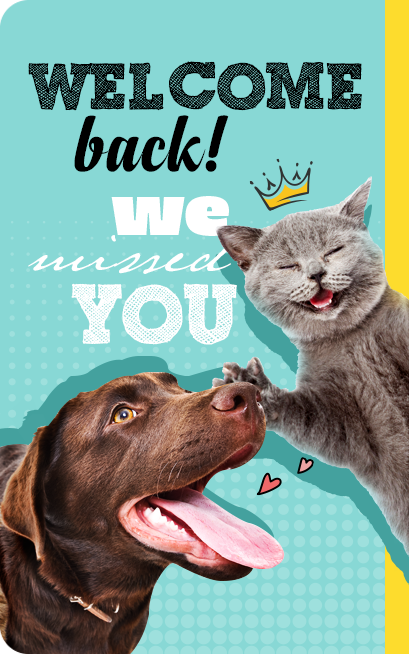Fun facts About Cats Body Language
Posted by Muskan bhardwaj on

Introduction
Cats are fascinating and enigmatic creatures. Their graceful movements and subtle behaviours often leave us wondering what's going on in their minds. Understanding your cat's body language is essential for building a strong bond with your feline friend. In this blog, we will delve into the intricate world of cat body language, exploring the signals, cues, and behaviours that can help you decipher what your cat is trying to communicate.
1. Tail Position

A cat's tail is a versatile tool for expressing emotions. Pay close attention to the following tail positions:
- Straight Up: When a cat holds its tail straight up, it is usually feeling confident and content. This is often seen when they greet you.
- Puffed Up: A puffed-up tail indicates fear or agitation. Your cat may be trying to appear larger to ward off a perceived threat.
- Tucked Between Legs: If your cat tucks its tail between its legs, it may be feeling scared or submissive.
- Twitching Tail: A twitching tail can signal excitement or irritation. It's crucial to assess other body language cues to understand the context.
2. Ears

- Forward and Relaxed: When your cat's ears are forward and relaxed, it's a sign of curiosity or friendliness. They are engaged and open to interaction.
- Flattened Back: Flattened ears indicate fear, anger, or aggression. Your cat may be upset or agitated.
- Rotated Sideways or Backward: Cats may rotate their ears to the side or backward when they're annoyed or displeased. This can be a precursor to aggressive behavior.
3. Purring

Purring is often associated with contentment, but it's not always that simple. Cats may purr when they are happy, but they can also purr when they are in pain, anxious, or seeking attention. Context and other body language cues can help you determine the reason behind the purring.
4. Kneading

When your cat kneads you or a soft surface with its paws, it's a behavior reminiscent of kittenhood. Cats knead when they are relaxed and content. It's a sign that they feel safe and comfortable.
5. Slow Blinking

Slow blinking from your cat is a gesture of trust and affection. When your cat slow blinks at you, try returning the gesture. This can reinforce the bond between you and your feline friend.
6. Whisker Position

Cats are highly attuned to their surroundings, and their whiskers play significant role in sensory perception:
- Forward and Relaxed Whiskers: This indicates your cat is at ease and curious.
- Whiskers Pulled Back: Pulled-back whiskers may signify fear or tension.
- Stiff Whiskers: When your cat's whiskers are stiff and pointed forward, they may be agitated or focused on something.
7. Eye Contact

Direct eye contact from your cat can have various meanings:
- Slow Blinking: As mentioned earlier, slow blinking is a sign of trust and affection.
- Staring: A cat's stare can be interpreted as a challenge or a sign of aggression. It's essential to break eye contact to avoid confrontation.
8. Body Posture

A cat's overall posture can provide valuable insights into their mood:
- Relaxed and Open: A cat with a relaxed body posture, lying on its back with the belly exposed, is feeling comfortable and secure.
- Crouched and Tense: A crouched stance with tense muscles suggests your cat is on alert, possibly preparing to pounce or flee.
- Arched Back: An arched back, often accompanied by puffed fur, is a defensive posture. Your cat may feel threatened or scared.
9. Hiding Behavior

Cats are experts at finding cozy hiding spots when they need a break or feel threatened. It's crucial to respect your cat's need for personal space and not force them out of their hiding spot. Give them time to relax and come out when they feel safe.
10. Vocalizations

Cats communicate through a variety of vocalizations, from meows and purrs to hisses and growls. Each sound carries its own meaning. For example:
- Meowing: Cats primarily meow to communicate with humans. The tone and frequency of meows can convey different needs or desires, such as hunger, attention, or distress.
- Hissing and Growling: These are signs of fear, anger, or aggression. It's best to give your cat space when they exhibit these vocalizations.
Understanding your cat's vocalizations, in combination with their body language, can help you respond appropriately to their needs.
11. Tail Fluffing

A fluffy tail is a sign that your cat is feeling threatened or scared. It's a natural response to make themselves appear larger and more intimidating to potential threats.
12. Scratching

Cats scratch to mark their territory and to sharpen their claws. If your cat is scratching inappropriately, such as on furniture, it may be a sign that they need a suitable scratching post or more playtime to expend energy.
Conclusion
Deciphering your cat's body language is an essential skill for any cat owner. By paying close attention to tail position, ear posture, vocalizations, and other cues, you can better understand your cat's emotions and respond appropriately to their needs. Remember that each cat is unique, and it may take time to become attuned to your specific feline friend's body language. Building a strong bond with your cat involves not only understanding their non-verbal cues but also respecting their boundaries and providing a safe and loving environment in which they can thrive.






